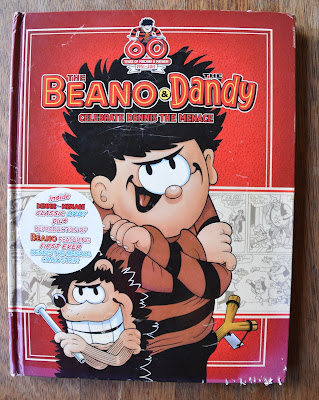
I can't believe I've never made a post about surely one of the most significant issues of a British comic - the final issue of Buster. Buster was the last survivor of a Fleetway comic, and for me this final issue is a sad marker for the end of an era.
For 32 pages for £1.10, it was probably the price that killed it to be honest. It was more than twice the price of The Beano (which cost 52p) at this point, and the quality simply wasn't as good.
Credit where credit is due, I do like this front cover. The main Buster strip is a reprint by Jimmy Hansen, but that bar on the left showing Buster's different styles through the years is by Jack Edward Oliver. Oliver was the sole artist held on at Buster after the comic went full reprint. Mostly, he was responsible for lettering and adding drawings to things that couldn't be done with reprints. I think it would be fair to say that he was largely influential for Buster's unique feel over those final years.
As mentioned, the contents was full of reprints but out of interest and the fact that they're still fun comic strips, I'll show some of it anyway. Perhaps of most interest would be this Specky Hector Comics Collector page, illustrated by Lew Stringer. This was obviously chosen for this last issue as it discusses the launch of Buster back in 1960.
Here's an oddly interesting page - a competition with a whole range of Meccano sets were up for grabs. I say this is odd because it seems strange to me that you would have a competition in the final issue, especially so when there's no other comic they were trying to drive readers to. Perhaps there was simply a pile of Meccano sitting around the office that they needed to get rid of.
Moving on to this Sweeny Toddler strip, illustrated by Tom Paterson. I wanted to share this page to highlight the colouring style that was so prevalent in Buster throughout the 1990s. This strange block colouring was far from the prettiest colouring ever done, but it did give the comic a unique feel and allowed them to brand it as full colour.
Here's an example of a perhaps more well-coloured spread. Bobby's Ghoul is illustrated by Anthony Hutchings, and Watford Gapp by Tom Paterson in a completely different style. I interviewed Tom for issue three of Atomic Comic a few years ago and asked him about this style, this is what he said:
"Bob Paynter, the managing editor at Fleetway, asked me to come up with a few ideas for some strange, slightly weird strips, one of which was Watford Gapp, and I just thought that it needed an alternative style to give it a different, darker look from my other strips which were running at the same time. I've worked in a number of styles over the years, but I enjoyed the Sweeny Toddler/ Calamity James style, which was of course inspired by the legendary comic genius Leo Baxendale - and the Watford Gapp one, which was influenced by the amazing Robert Crumb."
And finally, it is of course the back cover that everybody remembers from this issue. Illustrated by Jack Edward Oliver, it's a wonderfully unique piece that wraps up all the remaining characters in a comedic fashion. Sad as it may be, it was a fantastic way to wrap up the comic.



































